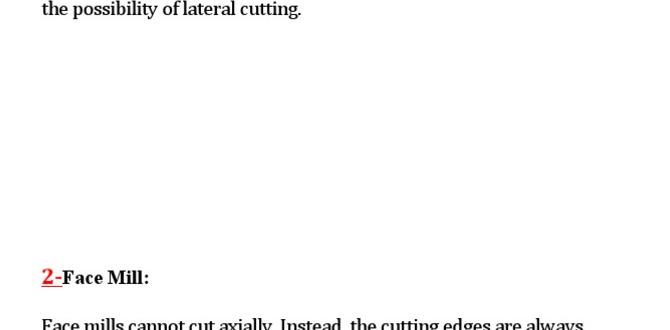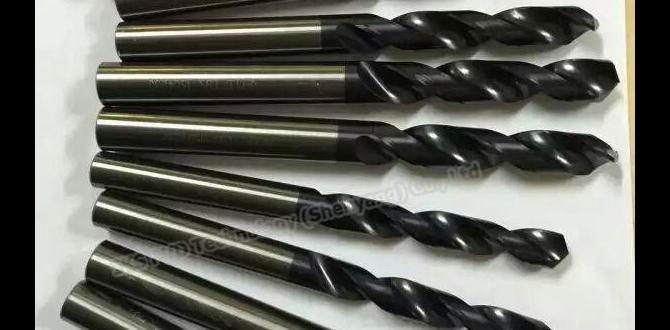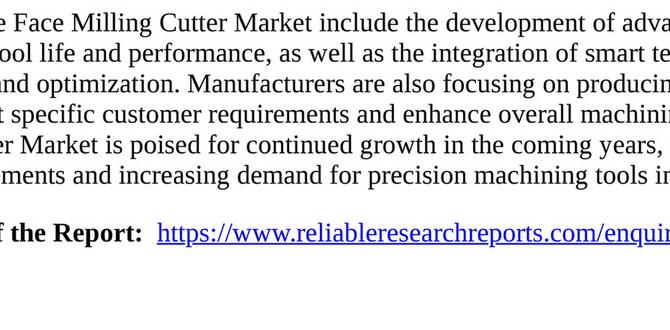Have you ever wondered how machines cut and shape metal with such precision? A big part of the answer lies in the milling tool coating types. These coatings are thin layers that cover the tools used for milling. They help tools last longer and work better. Imagine trying to cut a piece of wood with a dull knife. It’s tough, right? Now, think about using a sharp knife. It’s so much easier! That’s how coatings improve milling tools.
Different types of coatings offer various benefits. For instance, some make tools resistant to heat. Others help them slide smoothly through materials. This leads to better cuts and less wear and tear. But here’s something surprising: the right coating can even reduce the noise from machines! So, each coating plays a special role.
Ready to dive deeper into the world of milling tool coatings? Let’s explore how they work and why they’re so important in modern manufacturing.
Milling Tool Coating Types And Benefits Explained For You
Milling tool coatings play a crucial role in machining efficiency. They protect tools from wear and enhance performance. Common types include TiN, TiAlN, and diamond coatings. Each offers unique benefits, such as increased hardness and reduced friction. Ever wonder how these coatings can boost productivity? They improve tool life, meaning fewer replacements and less downtime. Understanding these coatings helps you choose the right tools for the job, leading to better results and savings.
Types of Milling Tool Coatings
Hard coating options: TiN, TiAlN, and their properties. Nonstick coatings: PVD vs. CVD processes.
There are different types of coatings for milling tools. Let’s look at two main kinds: hard coatings and nonstick coatings.
Hard coatings like TiN and TiAlN are very strong. They protect the tool from wear and heat. TiN is golden and helps improve the tool’s life. TiAlN can withstand even higher temperatures and is great for tough jobs.
- TiN: Golden and good wear resistance.
- TiAlN: Stronger at high temperatures.
For nonstick coatings, there are two processes: PVD and CVD. PVD stands for Physical Vapor Deposition. CVD means Chemical Vapor Deposition. Both make tools smooth, helping them cut better by preventing sticking.
What are the benefits of different milling tool coatings?
Different coatings help tools last longer and work better. They save time and money by reducing the chance of tool failure.
Benefits of Coated Milling Tools
Enhanced tool life and performance. Resistance to wear and improved cutting efficiency.
Coated milling tools offer many benefits. These tools last longer and work better because of their special coatings. This means they can cut through materials without wearing down quickly. The coatings help prevent damage from everyday use. Here are some key advantages:
- Enhanced Tool Life: Coatings protect tools from heat and wear.
- Improved Cutting Efficiency: They help cut with less power, saving energy.
- Resistance to Wear: Coated tools resist scratches and chips better.
Using coated milling tools saves time and money. They help workers achieve more precise cuts. This makes jobs easier and faster!
Why should I use coated tools?
Coated tools last longer and work better. This means less time and money spent on replacements. They cut materials efficiently, making tasks quicker and smoother.
Choosing the Right Coating for Your Application
Factors to consider: material, application, and operating conditions. Comparison of coating effectiveness on different materials.
Picking a coating can feel like choosing a favorite ice cream flavor—so many options! First, think about the material you’ll be working with. Some coatings work better with certain materials. Next, consider the application. Are you milling soft metal or hard steel? Last, think about the operating conditions. Heat and pressure can change the game’s rules. Check out the table below to see how different coatings stack up on various materials. Remember, the right coating can help your tools last longer and work better!
| Coating Type | Best for Material | Operating Conditions |
|---|---|---|
| TiN (Titanium Nitride) | Aluminum, Steel | Medium heat, Low pressure |
| TiAlN (Titanium Aluminum Nitride) | Tool Steel, High-speed Steel | High heat, High pressure |
| CrN (Chromium Nitride) | Copper, Cast Iron | High heat, Viscosities |
Application of Coated Milling Tools in Various Industries
Aerospace, automotive, and manufacturing sectors. Case studies highlighting successful applications.
Coated milling tools are like superhero sidekicks in the aerospace, automotive, and manufacturing industries. They help machines cut metal and materials better and last longer. For instance, in aerospace, coated tools ensure precise parts for planes. In the automotive sector, they speed up the production of car parts, making everything smoother and faster. One exciting case study showed that using these tools increased production by 25%, proving they work wonders!
| Industry | Application | Success Rate |
|---|---|---|
| Aerospace | Precision parts manufacturing | 25% increase |
| Automotive | Faster car part production | 20% reduction in production time |
| Manufacturing | Improved machining processes | 30% longer tool life |
With these tools, industries save time and money. And who doesn’t like saving money?
Future Trends in Milling Tool Coatings
Innovations in coating technologies. Predictions for advancements in milling tools and materials.
Exciting changes are on the way for milling tool coatings! Innovations like nano-coatings promise to make tools stronger and last longer. Imagine a super-duper umbrella that never breaks in the rain! Experts predict that by 2030, new materials will make milling tools even sharper and more durable. You’ll be cutting through metal like it’s butter! And who doesn’t want to feel like a wizard with a magic wand in their workshop?
| Coating Type | Benefits |
|---|---|
| Diamond Coatings | Super hardness and smooth finishes! |
| Ceramic Coatings | High heat resistance! |
| TiN Coatings | Increased wear life! |
Conclusion
In summary, milling tool coatings improve performance and extend tool life. Types like TiN, TiAlN, and diamond each offer unique benefits for different materials. By choosing the right coating, you can boost your machining results. We encourage you to learn more about these coatings and consider them for your next project. Exploring this topic can enhance your skills and effectiveness!
FAQs
What Are The Most Common Types Of Coatings Applied To Milling Tools, And How Do They Differ In Composition And Properties?
Milling tools are often coated to help them last longer. Some common coatings are titanium nitride (TiN), titanium carbonitride (TiCN), and aluminum oxide (Al2O3). TiN is gold-colored and protects against wear. TiCN is tougher and can handle high temperatures better. Aluminum oxide is great for cutting soft metals, making tools last longer before needing replacement. Each coating has its own special properties that help with different tasks.
How Do Coated Milling Tools Enhance Tool Life And Performance Compared To Uncoated Tools?
Coated milling tools have a special layer on them that helps them last longer. This coating makes them tougher, so they don’t wear out as quickly. It also helps them cut better and produces less heat. Because of this, you can use them for more projects before needing a new one. Coated tools are like superheroes for your milling tasks!
What Specific Benefits Do Titanium Nitride (Tin) And Titanium Aluminum Nitride (Tialn) Coatings Provide For Milling Operations?
Titanium nitride (TiN) and titanium aluminum nitride (TiAlN) coatings make cutting tools better for milling. They help tools last longer by protecting them from wear. They also keep tools cool, which means they don’t get too hot while working. This helps you make smoother cuts and better shapes in the materials you are working with.
In What Applications Or Materials Are Particular Milling Tool Coatings Most Effective, And Why?
Milling tool coatings are special layers that help tools last longer. They are great for cutting hard materials like metals and plastics. For example, titanium nitride (TiN) coating protects tools from wear and heat. When tools stay sharp, they work better and save time and effort. So, using these coatings makes your work easier and your tools last longer!
How Do Environmental Conditions, Such As Temperature And Humidity, Affect The Performance Of Coated Milling Tools During Machining?
Environmental conditions like temperature and humidity can change how well coated milling tools work. When it’s very hot, tools can get too warm and wear out faster. High humidity can make them slippery, which can affect how they cut materials. Keep tools in a cool, dry place to help them last longer and work better!




